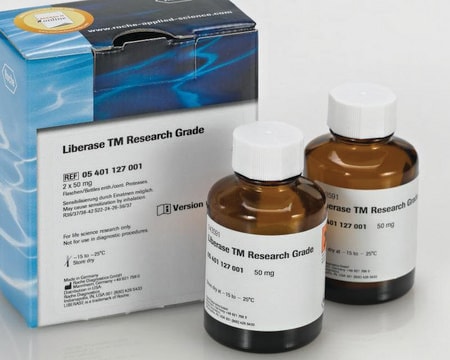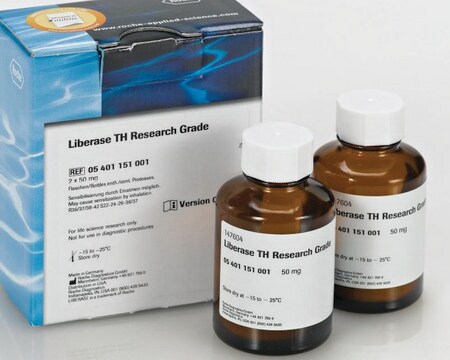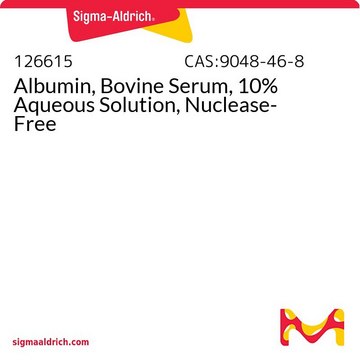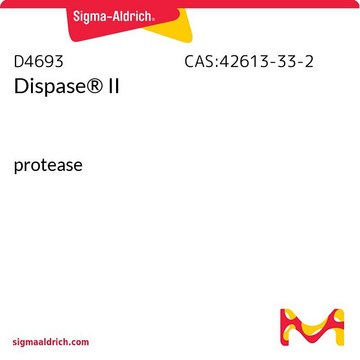05401020001
Roche
Liberase™ TL Research Grade
lyophilized, suitable for tissue processing, optimum pH 7.4
Synonym(s):
collagenase | Tissue dissociation
About This Item
Recommended Products
biological source
Bacillus polymyxa (dispase)
Bacillus sp. (thermolysin - Bacillus thermoproteolyticus)
Clostridium histolyticum (collagenase)
Quality Level
description
low Thermolysin concentration
form
lyophilized
packaging
pkg of 10 mg (2x5 mg)
manufacturer/tradename
Roche
parameter
35-37 °C optimum reaction temp.
technique(s)
tissue processing: suitable
optimum pH
7.4
Related Categories
General description
Liberase Purified Enzyme Blends
Liberase enzymes are blends of highly purified enzymes, designed to increase the quality and reproducibility of tissue dissociation, and improve the viability and functionality of isolated cells. Liberase Purified Enzyme Blends replace traditional collagenase, which is a crude and variable fermentation by-product of Clostridium histolyticum.
Liberase Enzyme Technology
Liberase enzyme technology comprises methods for purifying clostridial collagenase isoforms to high specific activity, and for blending them together with high-specific-activity neutral protease in optimal ratios for effective dissociation of primary tissues and cultured cells.
For additional information, such as manufacturing, technology, or storage, see the Liberase Research Grade Insightsdocument. Further reading on the topic can also be found in the Documents tab.
Roche provides special-quality preparations of Liberase Purified Enzyme Blends, manufactured to meet GMP requirements. For more information on the GMP-grade preparations.
Important Notes:
- This product is intended for life science research and in vitro use only. These products are not to be used for diagnostic or clinical applications, such as human islet transplantation.
- All 1st generation Liberase and Liberase Blendzyme products (Liberase HI, CI, RI, PI, Liberase Blendzyme 1, 2, 3, 4) have been replaced by the 2nd generation Liberase Research Grade and Liberase GMP grade enzyme blend portfolios. For instructions concerning the transition from previously used Liberase Enzymes.
Application
This product has been used for the isolation of pancreatic islets from mice.
Features and Benefits
- Maximize viability and yield of isolated cells with an enzyme blend that has less clostripain and trypsin activity, as well as reduced endotoxin content.
- Count on higher specific activity of the enzyme blend as a result of higher Collagenase I + II purit(determined by HPLC analysis)
- Obtain higher experimental reproducibility due to higher lot-to-lot consistency.
- Increase safety with an enzyme that is free of any mammalian or avian tissue-derived raw materials.
Preparation Note
Working concentration: Liberase Research Grade Enzyme Working Concentration
Liberase enzymes have significantly higher specific activities than traditional collagenases. This means that the working concentration of Liberase Research Grade Purified Enzymes, expressed in mg/ml, will be lower than that of traditional collagenase.
When the application is on the Roche list of applications at www.collagenase.com, use the Liberase Research Grade concentration recommended for that application.
When the application is not included on this list, first use Liberase TM Research Grade at a concentration of 0.08–0.28 Wünsch units/ml.
The goal is to determine the best starting concentration of Liberase Research Grade Enzyme Blends. This is a starting point, and the final concentration may vary due to differences in procedure and lot-to-lot differences in traditional collagenase.
Collagenase Working Concentration
Multiply your previous collagenase working concentration (mg/ml) by its specific activity (Wünsch units/mg, [as determined above]), to obtain Wünsch units/ml. To determine how much Liberase Research Grade Enzyme Blend to use, first multiply your collagenase working concentration (in Wünsch units/ml) times the total volume of your working enzyme solution to obtain the total collagenase activity needed (Wünsch units). Divide the total collagenase activity required by the Liberase Research Grade stock concentration ( “Reconstitution and Storage”). This indicates how many milliliters of Liberase Research Grade Enzyme Blend stock solution to use in your working enzyme solution.
Storage conditions (working solution): Store unused stock solution in single-use aliquots at -15 to -25 °C. For further information on product stability, please visit the Roche Liberase Enzyme website at www.collagenase.com.
Note: Avoid repeated freezing and thawing!
Reconstitution
Reconstitute the entire vial. Do not weigh individual aliquots of the lyophilizate. The introduction of moisture into the vial results in a decline in enzymatic activity.
Place vial on ice to rehydrate the lyophilized enzyme.
Gently agitate the vial at 2 to 8 °C until enzyme is completely dissolved (max. 30 min).
Depending on the type of tissue-dissociation buffer used to dissolve Liberase Research Grade Purified Enzyme Blends, slight precipitations may be observed which readily dissolve in the diluted working solution and have no influence on enzyme activity.
Remove an aliquot of the stock solution to prepare the working solution
Reconstitution volume
2 ml (1 vial with 5 mg–10 mg pack size), 10 ml (1 vial with 50 mg–100 mg pack size)
Collagenase Wünsch (units/ml)
13 (1 vial with 5 mg–10 mg pack size), 26 (1 vial with 50 mg–100 mg pack size)
Total Collagenase concentration [mg/ml]
2.5 (1 vial with 5 mg–10 mg pack size), 5.0 (1 vial with 50 mg–100 mg pack size)
Storage and Stability
Other Notes
Legal Information
also commonly purchased with this product
Signal Word
Danger
Hazard Statements
Precautionary Statements
Hazard Classifications
Eye Irrit. 2 - Resp. Sens. 1 - Skin Irrit. 2 - STOT SE 3
Target Organs
Respiratory system
Storage Class Code
11 - Combustible Solids
WGK
WGK 1
Flash Point(F)
does not flash
Flash Point(C)
does not flash
Choose from one of the most recent versions:
Already Own This Product?
Find documentation for the products that you have recently purchased in the Document Library.
Customers Also Viewed
Articles
Enzyme Explorer Key Resource: Collagenase Guide.Collagenases, enzymes that break down the native collagen that holds animal tissues together, are made by a variety of microorganisms and by many different animal cells.
Protocols
Liberase™ TL Research Grade Protocol & Troubleshooting
Related Content
Collagenase Guide.Collagenases, enzymes that break down the native collagen that holds animal tissues together, are made by a variety of microorganisms and by many different animal cells.
Our team of scientists has experience in all areas of research including Life Science, Material Science, Chemical Synthesis, Chromatography, Analytical and many others.
Contact Technical Service











